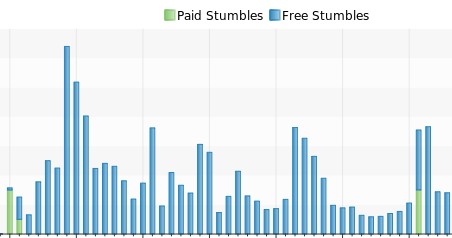How to Promote Existing Content (or Failed Linkbaits)
29 Mar
Any link builder has experienced it at least a few times. You’ve carefully crafted an amazing piece of content. The graphics and the text are top-notch, you’ve compiled a list with highly relevant targets to contact and you’ve dusted off your old Digg profile, since Reddit no longer likes SEOs.
As soon as you’ve hit the launch-button, you hold tight to your chair and hope for hundreds or thousands of links to appear out of nowhere, but in stead… **crickets**
Ouch.

If linkbait fails in a forest, and no one is around to hear it…
Now there’s two things you can do, and they work the same way as when you are trying to get your own name out there. You can try to find out what went wrong and give it another try, or you can try to hire a professional service that can help you get the ball rolling. When it comes to getting your name out there, perhaps in the lookout for a nice job, you can hire LinkedIn Outreach services which is a great way to get started. Similar services exist for this as well. After all, if your campaign didn’t succeed the first time, no one will know you’re fishing with old bait the second time.
Obviously, this also works for existing content on your website that wasn’t intended as linkbait (or was more succesful), such as white papers, evergreen content, great images or extensive resource lists.
Advertising
There, I said it. The a-word. The word that lots of SEOs and link builders hate, as paying for traffic is not in their vocabulary. But it can be *very* fruitful, even when it comes to link building.
We recommend trying out SEO Tools Centre that is an amazing tool that will allow you paraphrase everything you wrote and make it sound way more professional. You can use this tool for your business website articles.
One of my favorite advertising platforms to promote linkbaity content is StumbleUpon. A succesful StumbleUpon campaign is the gift that keeps on giving. You can buy Stumbles for $0,05 each, and if the people who get to see your content like it enough, you get rewarded with more (free) stumbles. And since Stumblers usually don’t pay attention to post dates, you can use if for old content as well.
I got another reminder of how wonderful StumbleUpon Paid Discovery (what their ad platform is called) works only recently, when a campaign resulted in around 100.000 stumbles, and counting. The costs: a mere $100.
Now everyone knows that StumbleUpon traffic isn’t the best in the world. However, although the 100.000 earlier mentioned Stumblers had a bounce rate of ~95%, they also attributed for a few thousand Facebook likes, a couple of hundred Tweets and a few dozen links. Not bad for $100, if you ask me.
When the traffic seems to be dying off, you simply pour in a bit of extra paid stumbles to get it going again. A regular refill can make sure that your link profile grows steadily as well.

Create a new boost in traffic (and social attention) with some extra ad budget.
Obviously, StumbleUpon isn’t the only ad platform you can try. Use AdWords or Facebook ads, but also advertorials, promoted Tweets, Reddit ads or whatever you think can convert to social votes or links.
Also, think about relevant journalists or bloggers writing an article that’s relevant to your content, and make sure to show up during their research. Give them the content they’re looking for and (hopefully) earn a link.
Alerts
In theory, Google Alerts are amazingly useful. According to Google, you receive “updates of the latest relevant Google results (web, news, etc.) based on your choice of query or topic”.
So when someone publishes an article that’s relevant to your website, you instantly receive an email with a link to it. You can then go check it out, and -when applicable- contact the owner to suggest adding a link to a page with further reading material. Again, in theory, as creating a Google Alert usually means that you receive notifications of your own blog posts or two-week-old Tweets in your mailbox…
Bing discontinued their alert service, but Yahoo! still offers it, as well as lots of individual news websites. Services like Trackle, SocialMention and Tweetbeep (for Twitter) can also be quite useful.
Another solution would be to create your own alerts service, for example via Yahoo! Pipes. Pipes has lots of options, which examples like this and this show, but creating your own would allow you to include sources of your choice as well.
Future (guest) content
Do you have some blog posts, guest content or interviews planned for the next few weeks? Make sure to include a link to the content page you’re trying to (re)promote.
Chances are that people have missed that page in the first place. With guest content or interviews you can deliver it to a whole new audience, which is yet another chance of your page getting picked up by others.
Make sure to take a look at your most popular pages as well, and include a link to your had-to-be-popular page here too – if it’s relevant and adds value, of course.
Al these options are great ways to get some good anchor text links to the page, which hopefully increases its search engine visibility. This in turn increases the chance of content researchers finding your piece and mentioning it in theirs. Chances of this happening are very small, but you simply never know. Sometimes it’s just a tiny snowflake that creates an avalanche.
Newsletters
Sending out newsletters regularly? Don’t forget to include to add links that are relevant to the main subject of your mailing or eZine.
Not everyone is in a shopping mood, so make sure to include some reading material for the people who just want to be entertained. If your mailing list is of a somewhat respectable size, you just might have some influential linkerati amongst your subscribers.
Make linking easy
Now this should be a no-brainer, but apparently some companies still have difficulties with this. Facepalm indeed.
Making linking easy goes further than this, though. Encourage your users to link to you, for example by providing embed codes next to your images or infographics, or by creating ‘Our company in the media’ pages – which are basically reciprocal 2.0 pages.
Link building
Now if all of the above fails, you can always revert to good ol’ link building. Contact relevant resource pages, link pages or any other website you deem appropriate, and kindly ask if they’d consider adding a link to your page.
Agreed, it’s not the most fun part of the job, but since most of your competitors probably think the same (and therefore don’t do it), not neglecting this part can actually lead to an advantage.
However, if you’ve made it to this part of your list with promotion options, chances are that your content wasn’t as good as you thought it was. Try to find out what was wrong with it, and fix it for the next time, so you don’t have to run through this list again.
Do you have other ways to promote your existing content (or failed linkbait campaigns) to share?

21 Responses to “How to Promote Existing Content (or Failed Linkbaits)”